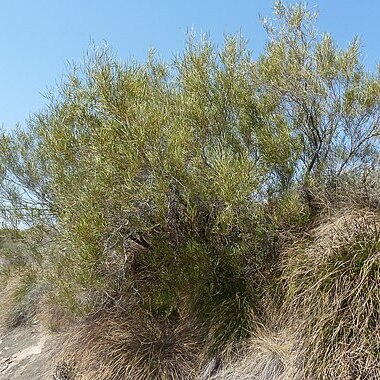Perennial shrub, 1-3 m high; much branched, multi-stemmed, rounded, often forming thickets, evergreen, young branchlets wiry. Leaves: petioles (8-)19(-30) mm long, trifoliolate; leaflets sessile, coriaceous, olive-green above, slightly paler below, linear, apex acute, often mucronulate, margins erose to grossly dentate, parted or divided, midrib prominent above and below; covered with shiny, resinous exudate. Inflorescence axillary and terminal panicles, multiflorous, occasionally glomerate. Flowering time Oct.-Mar. Fruit a drupe, circular, globoid, glabrous, shiny, light brown.
Shrub, 5-6 feet, much branched, branches sub-flexuose, angulate. Petioles sub-terete, furrowed above, an inch long or longer. Leaflets 3-3.5 inches long, 1.5-3 lines wide, with the middle nerve on both sides prominent, reticulate, undulate-dentate, teeth short, acute; the lateral leaflets incurved, erect, somewhat shorter than the terminal. Panicles about 2 inches long, di-or trichotomous, pedicels sub-flexuose, ultimate short. Drupe yellowish, shining, size of a peppercorn.
Much-branched, multistemmed, wiry shrub, up to 3 m high, often forming colonies; unarmed. Branches grey, prominently lenticellate. Leaflets sessile; blade linear, lateral leaflets often falcate, margins irregularly but prominently toothed (erose), surface sticky; terminal leaflet (25-)51(-90) x (3-)6(-12) mm. Flowers: Nov.-Mar. Fruit a globose, glabrous drupe.
A wiry shrub. It can grow 2-3 m tall. It has dense leaves. The leaflets are 9-10 cm long by 5-9 cm wide. The edges are wavy and have teeth. The flower panicles are 5 cm long. The fleshy fruit is yellow and shiny.

